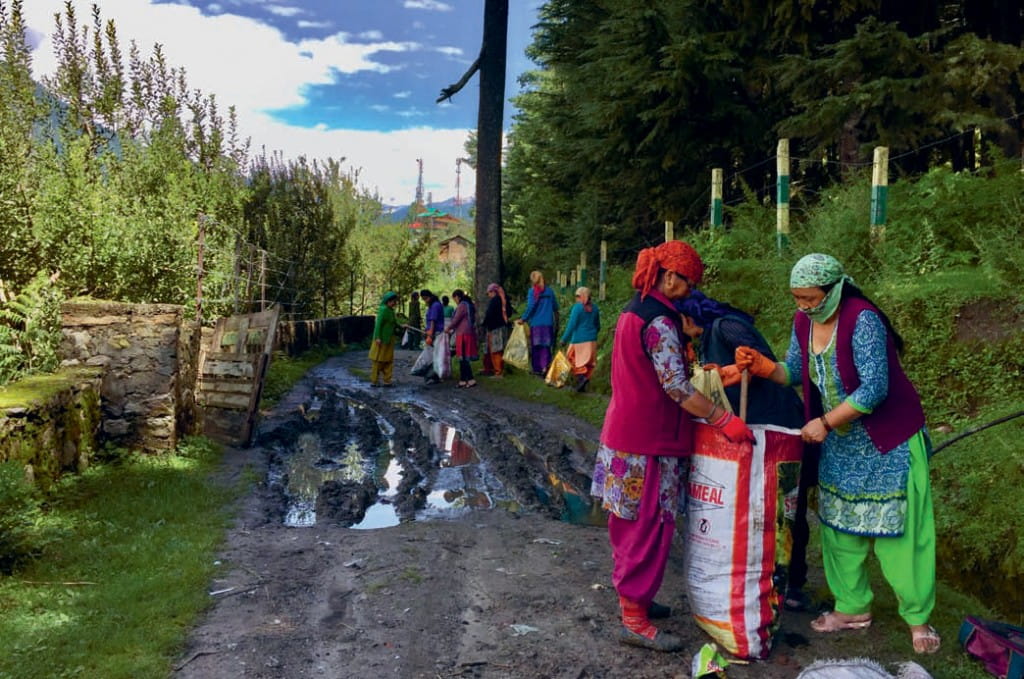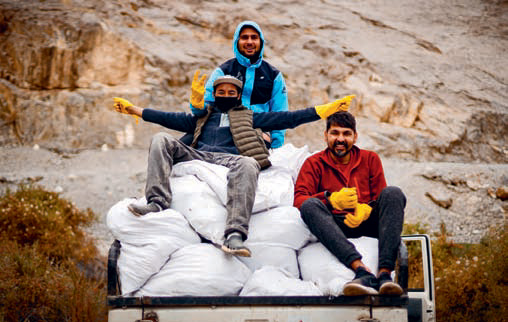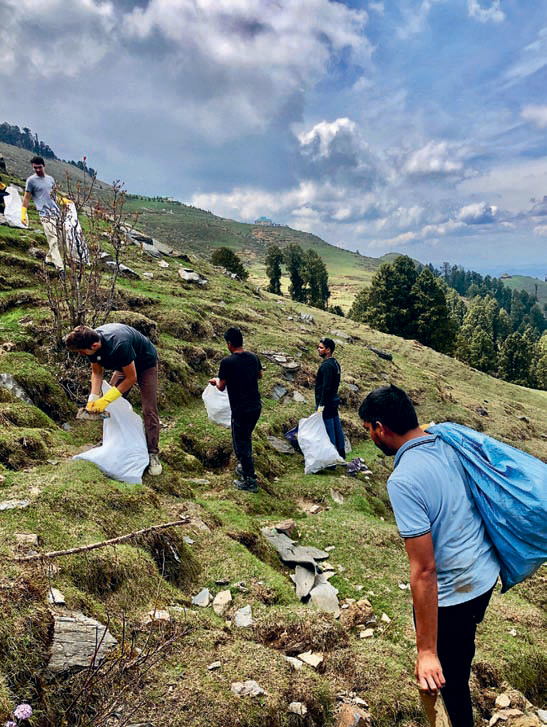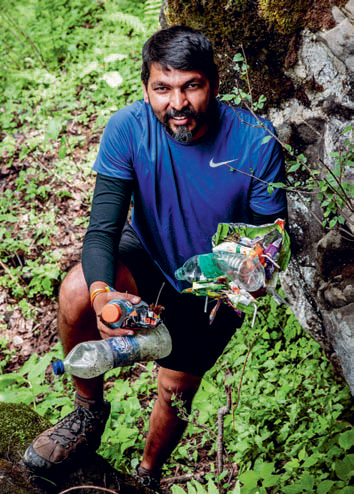Stories > The Mountain Healer
The Mountain Healer
Perturbed by the amount of waste that is polluting the Himalayas, avid trekker and nature lover Pradeep Sangwan decided to make cleaning up the region his business.
BY ZHOU XIJIE

The mission of Healing Himalayas is to keep the mountains clean. Local villagers are taking the initiative to join the movement.
ome to more than 50 mountains and the majority of the world’s highest peaks, the Himalayas are the closest one can get to the heavens with one’s feet still on the ground. Hindus and Buddhists who call these pristine mountains home consider them to be sacred land.
Indeed, spirituality had a part to play in Pradeep Sangwan’s decision to leave behind his comfortable life in the northern Indian state of Haryana, one of the most prosperous in the subcontinent, for the resort town of Manali in Himachal Pradesh that is tucked away in the mountains.
“I still can’t figure out why I decided to move but I think God had a part to play. It was an invisible force that drove me here. It’s hard to explain what I felt,” says the 34-year-old.

Pradeep Sangwan (in red) gave up a comfortable city life to start the nonprofit organisation.
He is, however, clear about one of the factors that compelled him to make the move: his love for nature.
Sangwan recalls falling in love with the majestic scenes during his college days when he started trekking. His connection continued into his days at military school when he did gardening.
In 2009, after graduating from college, he threw caution to the wind and packed his bags for Manali, much to the disapproval of his family. He admits that he didn’t really have a game plan. He just wanted to explore his passion for trekking.
He first made a humble living by operating a tiny café in the village of Kothi, which is situated in the Kullu district along the route to the Rohtang Pass, a popular tourist destination.
“Those years of running the café were a beautiful phase in my life. It taught me a lot about local culture, nature and even myself,” he says.
TACKLING WIDESPREAD POLLUTION
But perhaps what affected him the most was the pollution problem in the mountains. While visiting neighbouring areas such as the Hamta Pass and Kheerganga, both of which are tourist hotspots, Sangwan was shocked by the amount of garbage that was strewn along the trails.
“Kheerganga is an easy trek, so it’s very popular with tourists. Over a long weekend, almost 5,000 trekkers could pass through this place, leaving behind a huge carbon footprint,” he shares.

More than 5,000 volunteers – both local and international – have helped to retrieve 400,000kg of garbage from the mountains.
“Humans can protect themselves from fellow human beings. But nature cannot fight against humans. This is why it is important for us to unite in our efforts to preserve the natural environment, the very place we live in.”
In April 2016, Sangwan set his mind on preserving the beauty and sanctity of the Himalayas by turning it into his full-time job. He established Healing Himalayas, a travel-cum-do good organisation that allows volunteers to take in the breathtaking scenes of nature while helping to address the garbage issue.
He takes just a small percentage of the fees he charges travellers for his daily needs, while the costs associated with the transportation of the waste to disposal sites, and the purchasing of gloves, masks and gunny sacks, come solely from fund-raising activities. As such, he found it tough running Healing Himalayas in the beginning, when his customer base was still growing.
Constricted by his humble savings, he sometimes had to borrow money from his friends and eat free meals provided by a Sikh community temple in Manikaran. In fact, he still occasionally faces cash flow issues, but is hardly fazed by them. “Yes, I do face money problems every now and then, but I don’t need much money. This minimalist lifestyle suits me,” he quips.
The company’s first outing to the Hamta Pass involved only four people. Today, just four years later, the organisation has attracted nearly 5,000 volunteers from around the world to help clean up the Himalayas. The amount of garbage they have retrieved weighs in excess of 400,000kg.
Healing Himalayas currently conducts cleaning-up operations in a variety of areas that caters to volunteers of all fitness levels. The shortest campaign lasts just one day and takes place in the city of Shimla. Meanwhile, intrepid trekkers have the option of the Spiti Valley and Shrikhand Mahadev Yatra, which are located at an altitude of 5,100 metres above sea level. These two treks could last from a week to 10 days.

Sangwan’s organisation helps local artisans recycle some of the discarded objects, such as glass and plastic bottles.
CREATING A DEEPER AWARENESS
Sangwan takes volunteers to villages along the treks where they would set up rubbish bins to facilitate the proper disposal of garbage. Volunteers also help to distribute jute bags to every household, clean up the streets and empty rubbish bins.
In the process, he has reached out to the local villagers for assistance. While he notes that getting people out of their homes to help is simple enough, asking them to do so on a regular basis used to be a problem. To convince locals of the significance of such activities, he held workshops to educate them on the importance of waste segregation and how they could adopt an eco-friendly lifestyle.
“I educated the villagers about how plastic and other types of garbage will eventually affect their agriculture and water supply in the long run,” he recalls. Awareness is all about reminding people of the ramifications. “I just stuck to that and the villagers were soon on board.”
The environment advocate’s actions have resonated not just with the local villagers but also mindful travellers from overseas – with a little help from Our Better World (OBW), the digital storytelling platform of the Singapore International Foundation.
Within two months of being featured on OBW, the non-profit saw 286 volunteer sign-ups and $4,625 in donations.
FAR-REACHING IMPACT
In addition to raising environmental consciousness, the actions of Healing Himalayas have benefitted some locals financially. For instance, Sangwan provides local artist Shirin Shaikh with glass bottles picked up on his treks so that the latter can create works of art that are sold to tourists.
Local villager Ashutosh Sharma is one of those who appreciate the work of Healing Himalayas.
“I’ve learnt new things about the world through others who take part in this initiative, and this has changed my perspective of nature and what we need to do to take care of it,” he says. Another villager, Tashi Negi, says that while he is heartened to see Sangwan working selflessly for the cause, he wishes that more locals would come forward to help make the movement sustainable in the long run.
“Humans Can Protect Themselves From Fellow Human Beings. But Nature Cannot Fight Against Humans. This Is Why It Is Important For Us To Unite In Our Efforts To Preserve The Natural Environment.”
Foreign volunteers, too, have benefitted from Sangwan’s efforts. Besides getting Instagram-worthy photos of the Himalayas, many have gained deeper insights into the Indian culture. Maria Schleicher is one such individual. An avid traveller, the German first heard of Healing Himalayas through an acquaintance she met on her travels in Australia. Intrigued by what she heard, she approached Sangwan and requested to do a six-month internship with the company.
“The locals are very keen on learning new things about waste management and are supportive of Pradeep’s ideas,” she says. “I can tell that they too are annoyed by how much waste is polluting the mountains.”
Schleicher conceded that she was initially apprehensive about going to India, given widely reported incidents involving violence against women in recent years.
“I was a young European woman travelling alone, so there were some concerns. But I just tried to keep an open mind and went ahead with the internship anyway,” she recalls.
“In the end, I only have positive feedback about the country and its people. In fact, all the people I worked with at Healing Himalayas were nice and respectful towards me. The way they treated me was better than how some of my compatriots would treat me. As long as you have an open mindset, India has nothing but warmth and love to offer.”

Scan the QR code or visit
www.ourbetterworld.org/story/
mountain-trash-healing-himalayas
to find out more.
